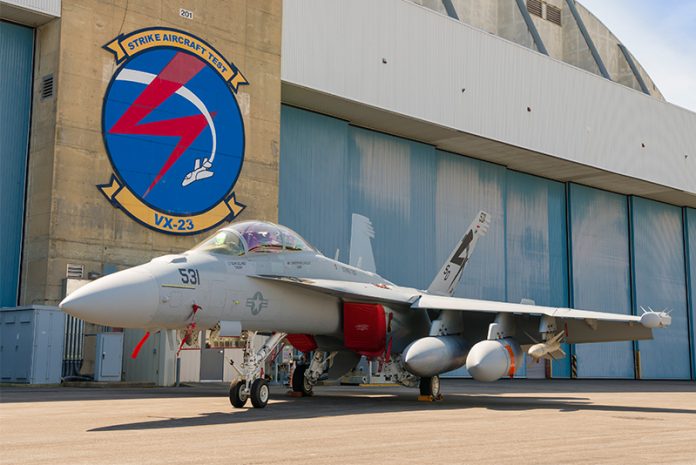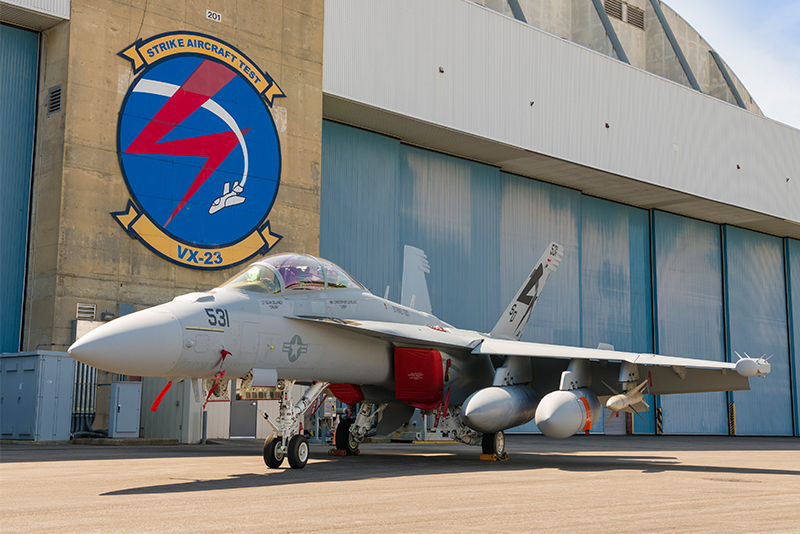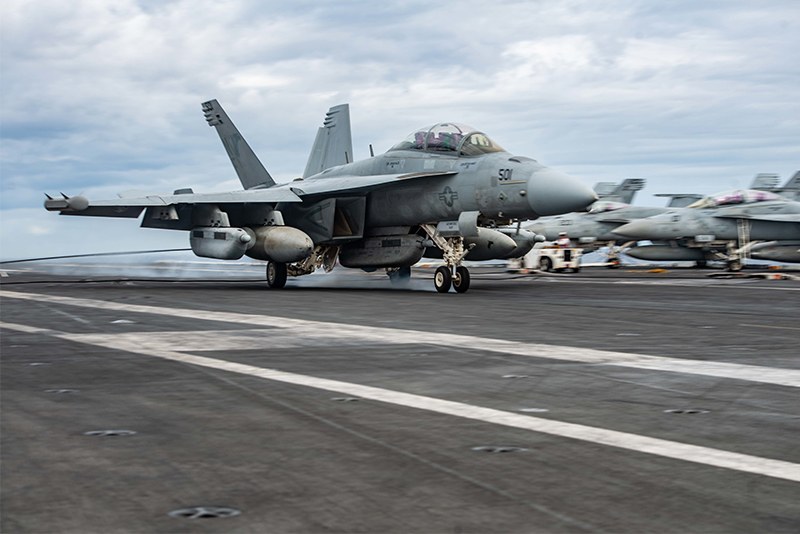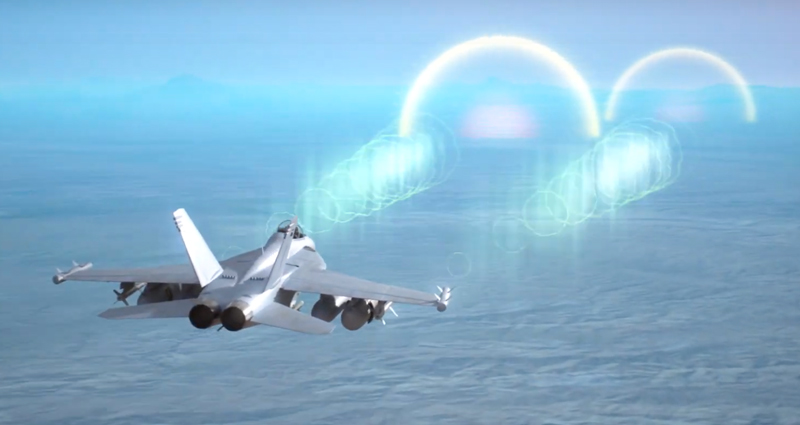A Deeper Growl
By
Mark Ayton
-
April 15, 2020

An EA-18G Growler assigned to Air Test and Evaluation Squadron 23 loaded with a ALQ-249 Next Gen Jammer pod on station 3 (middle).
Share on Facebook
Share on Twitter
Share on LinkedIn
One of the most powerful weapon systems in America’s arsenal, the EA-18G Growler, is about to get even better with the introduction of the Next Gen Jammer.
Pacific Fleet
Today, all Boeing EA-18G Growler aircraft are assigned to bases located around the Pacific. Naval Air Station Whidbey Island in Washington state is the EA-18G Growler master jet base. Whidbey is also home to Commander, Electronic Attack Wing, US Pacific Fleet, the parent wing for all Growler-equipped Electronic Attack Squadrons; a fleet replacement squadron, nine carrier-assigned squadrons and five land-based joint expeditionary squadrons. The latter are manned by both US Navy (USN) and US Air Force (USAF) personnel. One of the carrier-assigned squadrons is based at Marine Corps Air Station Iwakuni in Japan.
Both the carrier-assigned and land-based Growler squadrons regularly deployed around the Pacific theatre. Joint expeditionary squadrons deploy to Misawa Air Base in northern Japan, Kadena Air Base, Okinawa, Anderson Air Base, Guam and Australia. Squadrons assigned to Pacific Fleet carriers transit across the theatre on regular deployments to the Persian Gulf, and on short cruises to participate in major exercises such as
RIMPAC,
Valiant Shield and
Northern Edge. These collective deployments make a much greater footprint around the Pacific theatre compared to those staged in the European and Central Command theatres.
However, the Growler’s Pacific theatre footprint is not just down to the USN, as Australia also operates the EA-18G with a single Royal Australian Air Force (RAAF) squadron based at RAAF Base Amberley, Queensland. Despite its one-squadron force, the presence of Australian Growlers on the Pacific theatre’s southern flank, based within deployable range of many areas of South East Asia represents a formidable capability in a politically tense part of the world.
Royal Australian Air Force Growlers from No.6 Squadron prepare for a mission during Exercise Pitch Black 2018.
Growler
Back in 2001, the US Department of Defense (DoD) tasked the Department of the Navy to undertake an analysis of alternatives for a new-generation electronic attack aircraft.
The result of the study was the EA-18G Growler, a variant of the F/A-18F Super Hornet, built and configured as a stand-off and escort jammer for the USN. Now in its second decade of service, the EA-18G continues to be the only dedicated tactical electronic attack aircraft in the DoD’s inventory.
Captain Jason Denney, the F/A-18 Hornet and EA-18G Growler programme manager with Naval Air Systems Command’s PMA-265 said the aircraft has a fantastic ability to disrupt signals, deny communications, jam radars and provide crucial support and intelligence, not just to a Navy strike group, but deployed combatant commanders. “The Growler’s ability to work with all other aircraft, not just those in the carrier air wing but within the DoD, makes it a critical node operating with deployed Air Force, Army and Marine Corps expeditionary units; interoperability is a large key performance parameter for the Growler.”
The EA-18G’s primary antennas and sensors are housed in two Northrop Grumman ALQ-218 wing-tip pods with additional antennas located on the forward and aft of the aircraft appropriately separated so the system correctly processes signals. Threats can be detected throughout the RF spectrum measured in small elements. The signal is handed over to a secondary receiver which measures very fine and parametric measurements of the frequency and amplitude. Geo-location of the threat is calculated by interferometry; measuring differences in phase, the waveform angle relative to the aircraft’s position in time.
Growler system software is embedded into the standard Super Hornet release but features a third level displaying all electronic attack options. Recognition of the aircraft’s electronic attack systems and the ALQ-218 activates the third level. Aircrew use HOTAS (hands on throttle and stick) controls to view, operate from and switch between all three levels of display.
One control capability of the advanced crew station is interlinking of the forward (pilot) and aft cockpits (electronic warfare officer or EWO) that allow the two crew to operate the aircraft and its system with full co-ordination; the EWO uses four primary displays in the aft cockpit which are inter-linked to the front seat.
Bring back (the stores load an aircraft is permitted to land back on the carrier’s flight deck with) is a design feature of all carrier-capable aircraft. Growlers only releasable stores (weapons) are AGM-88 HARM, AGM-88E AARGM and AIM-120 AMRAAM missiles; otherwise its full stores load has to return to the ship. During carrier suitability trials, VX-23 undertook gross-weight expansion testing to increase the Growler’s bring-back capability to 48,000lb (21,773kg) including fuels, up from the Super Hornet’s 44,000lb (19,958kg) load. This involved launch and recovery operations using a test aircraft loaded to its heaviest configuration.
Catapult shots had to ensure tow-bar, nose-bar, gear and hook point loads were within the required limits for launching the aircraft. Arrested landings with a gross weight of 48,000lb were conducted under various simulated conditions to test de-acceleration, high-sink rate landings, roll/yaw offset landings and different attitudes.
Tactical jamming systems
However, the EA-18G aircraft is only part of the Growler weapons system. The electronic attack mission is conducted by the EDO ALQ-99 tactical jamming system in US Navy operation since 1971. Continual upgrades have enabled the ALQ-99 to remain relevant against potential threats from around the world. Different types of ALQ-99 pod are dedicated to notional wave bands and therefore target sets and what the attack solution should be.
Over the past 35 years, the ALQ-99 has been upgraded in different ways; by either wave band, by radio frequency exciter or by universal exciter. Back in 2005 the ALQ-99 system hit its technology ceiling. Certain new target sets can be accommodated with small tweaks to the system, those of a communication or asymmetric warfare type, but for the latest surface-to-air missile systems, the ceiling was inhibitive. New architecture was required.
An alternative of alternatives for a Next Generation Jammer (NGJ) was undertaken, and completed in April 2010. That November, a resources, requirements and review (R3) board sat at the Pentagon, which provided validation to build the system for use by the EA-18G. During 2010, technology and maturity contracts were awarded to Raytheon, Northrop Grumman, ITT with Boeing, and BAE Systems focussed on maturing the technology required for the context of the NGJ system.
Providing sufficient power and cooling for an electronic attack capability on a tactical size aircraft is a big challenge. There’s a trade-off between power and range which is constrained by physics; the more power the more generation required, but the EA-18G does not generate a lot of excess power so power generation needs to be built into the pod.
The ALQ-99 uses externally-mounted RAM air turbines, a pitched propeller that generates a lot of power. That’s not an option for the NGJ because the power required by its solid state and active array technologies is too great for an externally-mounted RAM air turbine as used by the ALQ-99; instead the pod uses an internal RAM air turbine generator dubbed the RAT G.
An EA-18G Growler from Electronic Attack Squadron 141 (VAQ-141) ‘Shad-owhawks’ lands on the flight deck aboard the aircraft carrier USS Ronald Reagan (CVN 76). Note the different side profiles of the under wing ALQ-99 pods compared to the centreline example.
Arrays also present unique challenges. An active electronically scanned array radar works best using a large flat plate, an arrangement that allows a good beam to be formed by focussing a lot of energy. Electronic attack is no different but for the requirement to have almost a 100 percent duty cycle active array for full-on jamming, which requires efficient beam formers and amplifiers. Use of gallium nitride circuits to enable close to 100 percent duty cycle jamming required this technology to be matured, such that development contracts were awarded to four companies in 2010. A follow-on contract for gallium nitride circuits was awarded to Raytheon in July 2013.
Next Generation Jammer
Under the Joint Electronics Type Designation System, the NGJ Mid-band is dubbed the ALQ-249; a high-powered, agile, electronic attack system capable of operating at stand-off ranges, attacking multiple targets simultaneously with advanced jamming techniques designed for rapid upgrades with a modular, open systems architecture.
Equipped with agile, active electronically scanned arrays and an all-digital back end, the ALQ-249 conducts precise jamming assignments against advanced and emerging threats operating throughout a wide range of radio frequency bands.
Confronted with integrated air defence system radars, communications, and data links, the ALQ-249’s ability to engage threat systems and conduct robust jamming at standoff distances is vital. Consequently, the ALQ-249 must provide sufficient effective isotropic radiated power (EIRP); the measured radiated (output) power of an antenna in a specific direction.
Once integrated on the EA-18G, the ALQ-249 will be capable of contributing to the full range of warfare from air strikes in anti-access/area denial environments to the type of irregular warfare encountered in Afghanistan.
The ALQ-249 pod is approximately 14ft (4.27m) long with a fuselage diameter close to 30 inches (760mm).
This image of a ALQ-249 NGJ Mid-band pod shows the aft and forward arrays.
NGJ Increments
One outcome of the November 2010 R3 board was to return the NGJ programme into incremental capabilities.
- Increment 1 is the mid-band, which covers the most critical threat waveforms across a full spectrum of agile and adaptive communications, datalinks, and non-traditional radio frequency targets.
Increment 1 will be used to deny, degrade, or deceive use of the electromagnetic spectrum employing both reactive and pre-emptive jamming techniques and is currently in the Engineering and Manufacturing Development (EMD) phase.
- Increment 2 is the low-band, which includes important threat waveforms and has an initial operating capability (IOC) targeted for after 2022.
- Increment 3 is the high-band with an IOC after 2024. This will be housed in a smaller pod carried on the outer wing stations 2 and 10.
Naval Air Systems Command currently describes Increment 2 and Increment 3 as planned future efforts.
April 2016 was an important month for the NGJ Mid-Band programme; it received Milestone B approval to enter EMD, and Raytheon was awarded a 56-month contract valued at $1 billion for execution of the EMD phase. In accordance with the contract, Raytheon will deliver 15 engineering development model pods to be used for mission systems testing and qualification, and 14 aeromechanical pods for airworthiness certification.
On 27 April, 2017, the NGJ programme completed its critical design review which identified deficiencies that deemed a redesign of the pod structure, which caused schedule and cost breaches to the programme. Despite the structure redesign development, manufacturing, integration and testing of the antenna arrays, power generation system, software, common electronics unit continued, in accordance with the EA-18G H16 software integration schedule.
On 18 October, 2017, a memorandum of understanding was signed with Australia forming a joint program office and a cooperative development programme. The Royal Australian Air Force is the only other air arm currently operating the EA-18G Growler.
Testing
Naval Air System Command’s anechoic chamber at Patuxent River is currently occupied by an EA-18G Growler aircraft fitted with the first set of two engineering development model mission system pods.
The aircraft and pods were first placed in the chamber last November. To date they have undertaken over 400 hours of testing with both pods radiating to check basic pod functionality and to capture electromagnetic interference data. The latter being the measurement of radiation data which is used to ensure the pod does not overheat or adversely affect the aircraft and the aircrew. Data captured in the chamber is also being used to gain an interim flight clearance authorisation to operate a Growler aircraft fitted with a set of NGJ pods in non-standard configurations, flight envelopes, or conditions.
The chamber testing is now providing real data, as opposed to analysed data, for use in the mission system modelling process to begin validation of the system. Prior to that, extensive mission system modelling of the pod’s application to electronic attack and jamming was based entirely on analysed data captured from ALQ-99 pods in operational scenarios.
An interesting perspective of electronic attack activity radiated from two ALQ-249 NGJ mid-band pods.
Stores integration
Last summer, Raytheon delivered the first NGJ Mid-Band EMD pod to Patuxent River to begin initial stores integration. This includes verification of ground procedures, mass properties, aircraft installation, and built in test checks, all in preparation for chamber and flight testing.
Different types of tests require different configurations of pods such as fatigue, static, jettison and aeromechanical versions; the latter used for flying qualities and aircraft integration. Pods used for mission system testing are in full-up configuration with all of the sub-systems installed. Unsurprisingly mission system pods are expensive and are actually unnecessary for some elements of the flight test programme.
Prior to first flight, the NGJ pod is undergoing all of the standard tests required for stores integration. Static strength testing was completed in the early autumn of 2019. Once flights begin, a set of NGJ pods will undergo captive carriage tests; loads, environmental, flying qualities, performance, drag and structural integrity. Performance and jettison tests will follow as part of the employment phase.
Captain Orr described the forthcoming NGJ flight test programme as thorough and extensive, involving hundreds of missions. It will involve aero mechanical testing of the pod’s physical integration on the aircraft; mission systems testing of the pod’s performance, and ultimately carrier suitability testing.
Chamber testing will continue for quite some time as its focus changes to increased performance. Milestone C, the low-rate initial production decision, is anticipated at the end of FY2020. Flight testing is expected to start this spring and continue through most of 2021.
An operational test readiness review should take place by early 2022. If the review is successful, the NGJ pod will enter operational test that year, followed by an initial operating capability declaration in FY2022.
Growler’s continuous improvement
As part of the Growler’s road map, the aircraft is continually improved primarily by the roughly biennial introduction of new operational flight program software drops. As a backdrop to the latest H14 software, the previous H12 release included another phase of multi-sensor integration improvements, enhanced ALQ-218 geolocation, communication countermeasures set improvements, display improvements (symbology and crew-vehicle interface) to enhance air-to-surface, air-to-air and counter electronic attack sensor integration to manage aircrew workload, and additional capabilities to operate in ATC-controlled airspace.
The latest, H14, commenced operational test in October 2018, concluded earlier this year, and has just been released to the fleet to meet the latest operational requirements. Last March, Naval Air Systems Command staged numerous fire control missions in an electronic attack environment at the sea test range off the coast of California.
In July, live fire missile testing was undertaken to demonstrate the integration of the AIM-120 AMRAAM missile with the Super Hornet and Growler aircraft operating with the H14 software.
PMA-265 is now underway with the developmental test of the subsequent H16 software which will provide:
- software and hardware upgrades to the ALQ-218 digital receiver
- an open architecture, multi-level secure processor known as the Distributed Tactical Processor-Network (DTP-N) reckoned to be 17-times more powerful than the original Growler system
- the Tactical Targeting Networking Technology (TTNT), a high throughput, low latency datalink called with satellite communications for advanced network connectivity.
Equipped with DTP-N and TTNT, a pair of Growlers will be able to fuse data acquired by on board and off board sensors to generate a common tactical picture of the battlespace and rapidly exchange that information with other assets. What does that achieve? It enhances targeting capabilities and improves air-to-air timelines and performance. This capability is scheduled to be implemented with several H-series software builds.
Back in August 2017, the Navy staged a series of fleet experiments called Netted Sensors 2017 conducted by the Navy Warfare Development Command involving, amongst others, F/A-18 Super Hornet and EA-18G Growler aircraft.
Focus of the experiments was sensor networking over the TTNT data link to enable distribution of information from around the maritime battlespace to all participating assets; aircraft, ships and shore stations.
EA-18Gs were focused on working a common tactical picture, multi-ship electronic surveillance, Growler manned-unmanned teaming, and network-centric collaborative targeting (NCCT) technologies. What does this all mean? It means using joint data standards and interfaces to speed up sensor cueing and targeting through to launching strikes in multi-sensor geolocation events.
Captain Denney outlined other initiatives to deliver new capability to the fleet faster to outpace potential threats, to improve and sustain aircraft mission capability rates by using predictive maintenance in order to spend time performing effective and proactive maintenance rather than reactive maintenance.
One change already in effect and in support of the above is migration from multi-sensor integration to multi-system integration. This allows for insertion of new technologies and requirements to keep pace with the fleet’s demands; this will continue with H16.
Block II Growler and the number one mission
Ongoing work is defining the Block II capability development programme, which will include conformal fuel tanks, in pretty much the same configuration as those under development for the Block III Super Hornet. Similarly, the advanced crew station featuring a large area display and low-profile head-up display will initially deploy on the Block III Super Hornet and then the Block II Growler.
Growlers are not equipped with a cannon, but the internal space is not left empty, it’s fitted out with an airborne electronic attack palette; this will be replaced with Block II to overcome obsolescence.
Given the relatively small fleet of aircraft, their ongoing utilisation rates, and an out-of-service date currently pitched for the mid-2040s, PMA-265 is already conducting a service life assessment programme to assess utilisation and when a service life extension programme will need to start. Captain Denney explained that because of the Growler’s utilisation, a service life extension programme will not start until after conversion to the Block II is complete. He said: “We are forecasting 2025 as the Block II IOC.”
When asked whether the PMA-265 team will be able to stay ahead of fast developing emerging threats, Captain Denney said it was the team’s number one mission: ”Our motto is to support, to sustain and advance the fleet. That is what we do, whether that’s getting the mission capability rate above 80 percent, or making sure the aircraft is able to fight and win against potential adversaries, that is why we make incremental improvements. We are developing the Block II Growler to exceed the capabilities of our potential adversaries.”
by Mark Ayton









